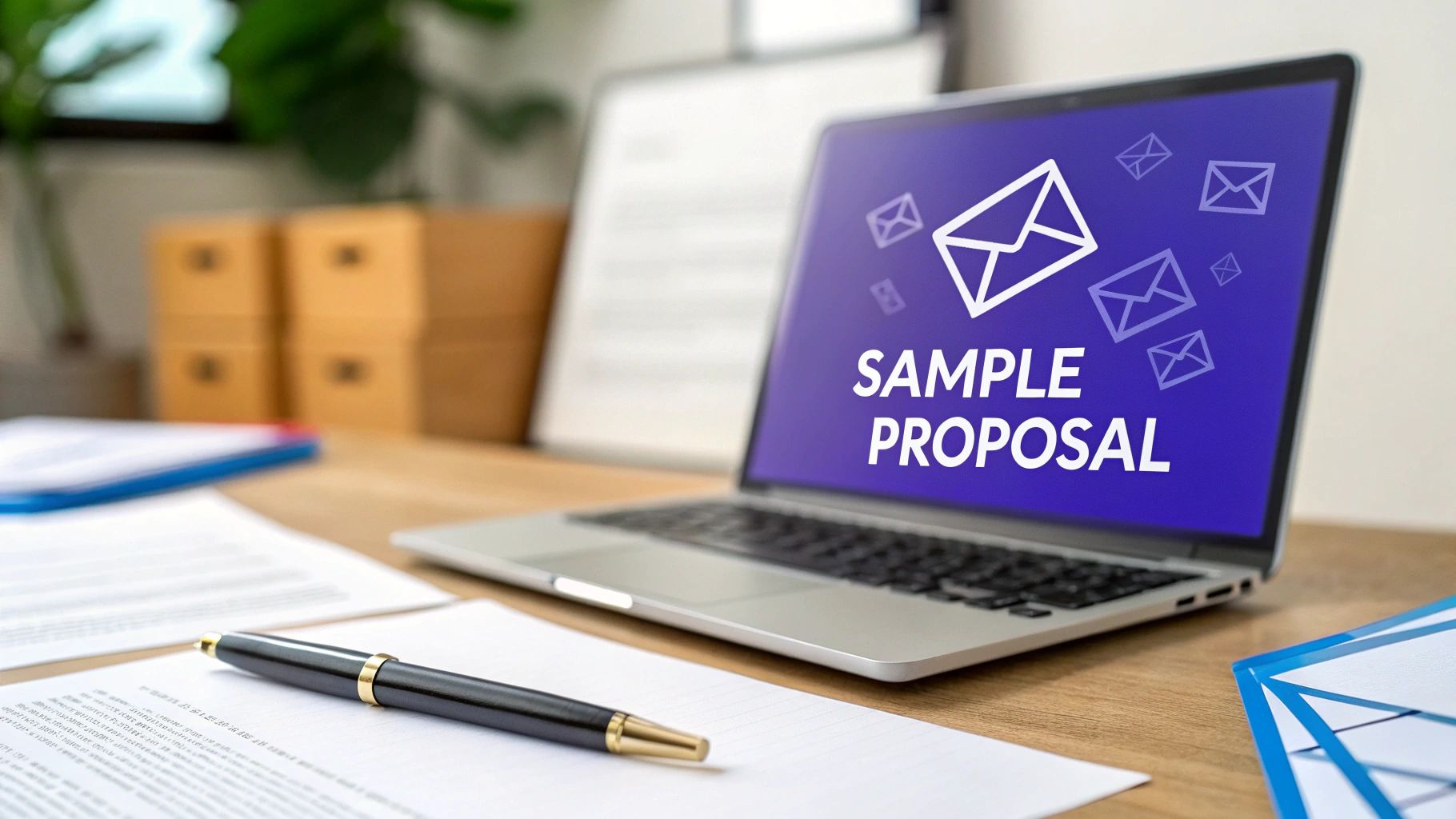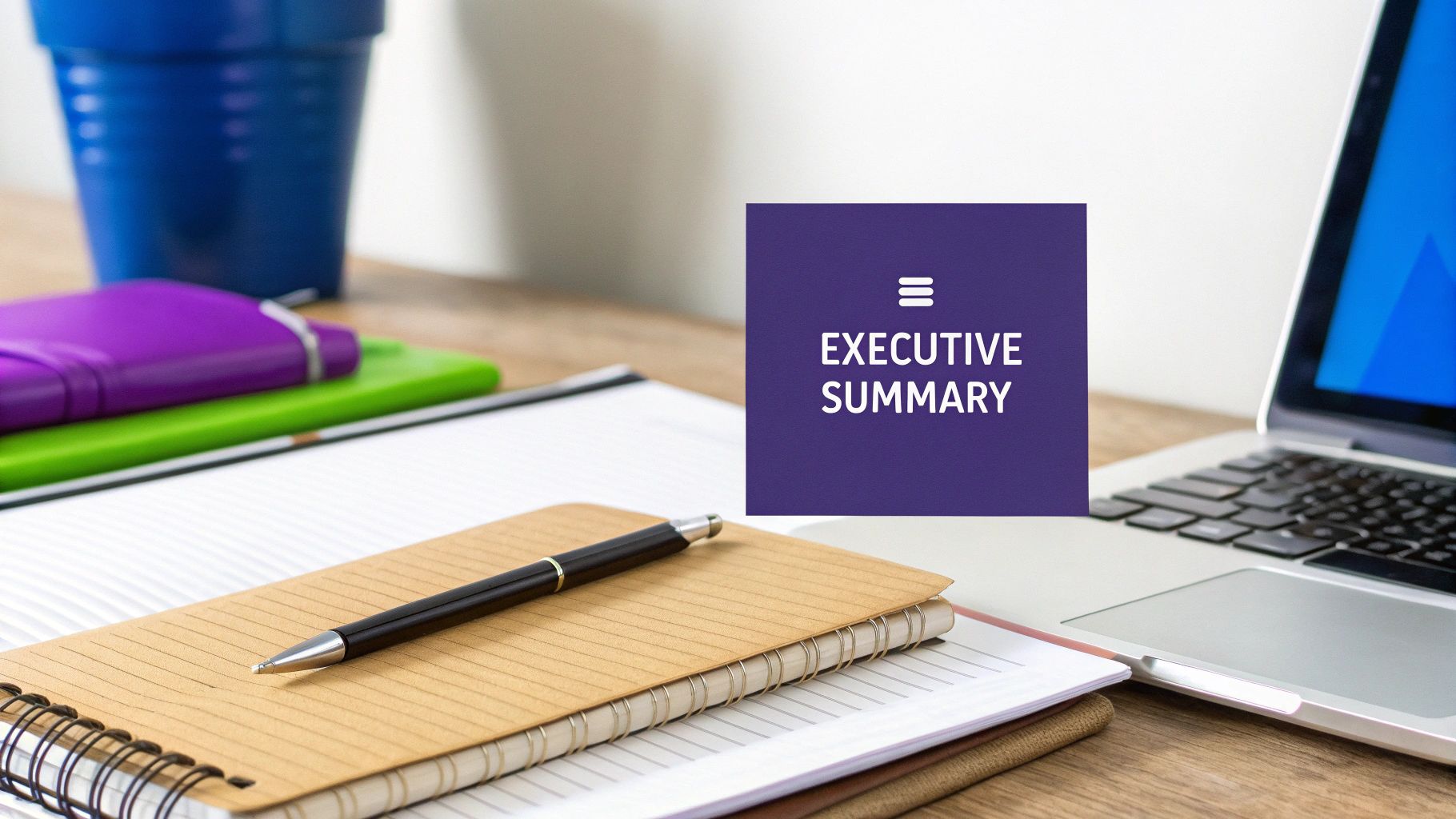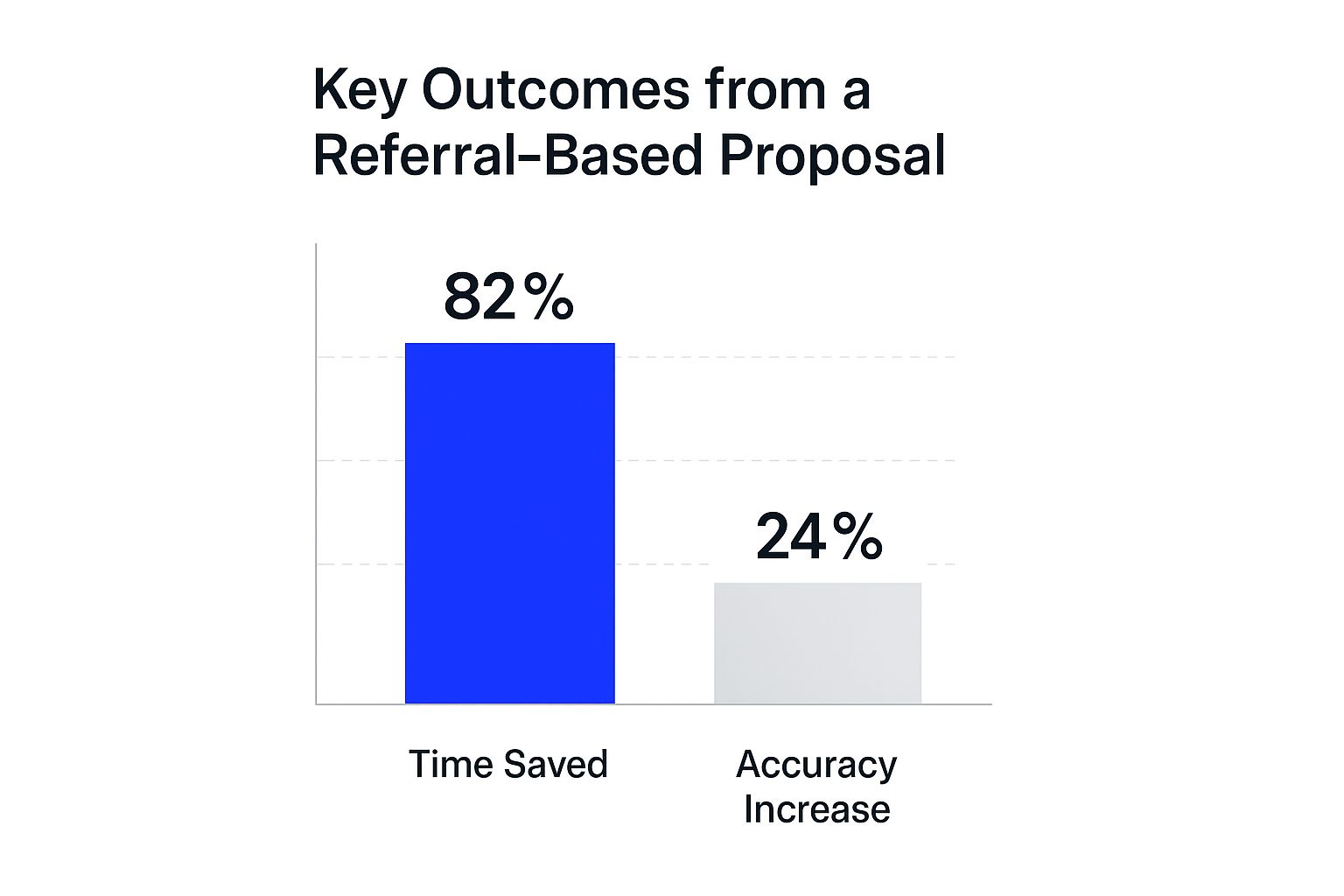Effective Sample Proposal Email Templates for Success
Unlock the secrets to writing effective proposal emails with our guide on six powerful formats: Problem-Solution, Executive Summary, Story-Based, Question-Led, Referral-Based, and Research-Backed. Each format is designed to engage your audience and increase your success rate. Discover practical tips, common mistakes to avoid, and how to leverage AI tools for refinement.

Unlocking Success: Crafting Winning Proposals via Email
Want to write proposals that close deals? This listicle provides six sample proposal email templates, each with a distinct approach. Learn the pros, cons, and practical tips for crafting compelling proposals, whether it's the problem-solution, executive summary, story-based, question-led, referral-based, or research-backed sample proposal email. Master these techniques to improve your persuasion skills and increase your success rate. We'll also show you how AI tools can refine these templates further. Effective proposals are crucial for securing new business, so let's get started.
1. The Problem-Solution Proposal Email
The Problem-Solution proposal email is a highly effective method for pitching ideas, products, or services by directly addressing the recipient's pain points and positioning your offering as the solution. This approach begins by clearly articulating a specific problem the recipient is facing, supported by data or evidence. It then immediately presents a concise solution, highlighting the measurable benefits of implementation. This framework creates a compelling narrative that resonates with busy professionals who appreciate a direct, value-driven approach.

This method deserves its place on this list due to its inherent persuasiveness. By leading with the problem, you capture the recipient's attention and demonstrate that you understand their challenges. This establishes relevance and opens the door for your proposed solution. Key features include a clear problem statement at the beginning, a concise solution presentation, data or evidence supporting the problem's existence, specific, measurable benefits derived from implementing the solution, and a brief implementation overview. This logical structure builds a persuasive argument, making it easy for recipients to grasp the value proposition.
Example:
Subject: Proposal to Reduce Your Customer Service Response Time by 45%
Dear [Name],
PROBLEM: Your current customer service team is handling over 500 inquiries daily with an average response time of 8 hours, leading to a 23% decrease in customer satisfaction scores over the past quarter.
SOLUTION: Our AI-powered ticketing system can integrate with your existing CRM to prioritize urgent requests and automate responses to common inquiries, reducing average response time to under 4 hours.
[Additional details about implementation and ROI...]
Pros:
- Creates immediate relevance by addressing known pain points.
- Makes a compelling business case quickly.
- Easy for busy executives to understand the value proposition.
- Follows a logical structure that builds persuasion.
Cons:
- Requires thorough research to accurately identify the recipient's problems.
- May come across as presumptuous if the problem analysis is incorrect.
- Can seem formulaic if not personalized effectively.
Tips for Effective Implementation:
- Thorough Research: Ensure the problem you identify genuinely exists and is a priority for the recipient. This is crucial for avoiding misfires and building credibility.
- Use Metrics: Quantify both the problem and the solution using specific data points. This adds weight to your claims and demonstrates the tangible value of your proposal.
- Conciseness: Keep the initial email concise (under 300 words) to respect the recipient's time.
- Call to Action: Include a clear call to action, such as suggesting a follow-up meeting or providing additional information.
- Personalization: Tailor the email to the specific recipient and their organization to avoid a generic, impersonal feel.
This approach, popularized by sales consultants like Jill Konrath and Oren Klaff and widely used in B2B SaaS outreach campaigns, is particularly effective when dealing with busy decision-makers who need to quickly understand the value proposition. When done well, the Problem-Solution email cuts through the noise and positions your proposal as the answer to a pressing challenge. Learn more about The Problem-Solution Proposal Email to refine your approach. This method is valuable for various professionals, from sales and marketing teams to customer support staff, freelancers, entrepreneurs, and even event organizers seeking sponsorship or partnerships. By understanding and addressing your target audience’s specific pain points, you create a much stronger and more persuasive proposal.
2. The Executive Summary Proposal Email
The Executive Summary Proposal Email is a powerful approach for delivering comprehensive proposals, especially to busy executives. It mirrors the structure of a formal business proposal's executive summary, condensing the key information into a concise, easily digestible email format. This method allows decision-makers to grasp the core components of your proposal quickly, facilitating faster decision-making processes. It's particularly effective for complex proposals requiring significant investment or long-term commitment. This method deserves its place on this list due to its effectiveness in conveying critical information efficiently and professionally.

This approach employs a structured format, typically including a brief introduction, a clear statement of purpose, a bulleted list of key deliverables, a summarized timeline and budget, expected outcomes and ROI (Return on Investment), and a clear call to action outlining next steps. By presenting this information upfront, you demonstrate professionalism and a thorough understanding of the recipient's needs and time constraints.
Features and Benefits:
- Concise Overview: Provides all essential information in a scannable format, respecting the recipient's time.
- Clear Structure: Uses headings and bullet points to enhance readability and comprehension.
- Comprehensive Information: Covers all crucial aspects of the proposal, from objectives and deliverables to budget and ROI.
- Professional Presentation: Projects a prepared and organized image.
Example:
Subject: Executive Summary: Website Redesign Proposal for [Company Name]
Dear [Name],
Please find below an executive summary of our proposal to redesign [Company]'s website:
OBJECTIVE: Complete redesign of corporate website to increase conversion rates by 35% and improve mobile user experience.
KEY DELIVERABLES:
- Responsive website design with updated branding
- E-commerce integration with existing inventory system
- SEO optimization with focus on 25 target keywords
- Content migration and restructuring
TIMELINE: 12 weeks from approval to launch
INVESTMENT: $45,000-$55,000 (detailed breakdown in attached document)
EXPECTED ROI: 250% within first 12 months based on projected conversion improvements
NEXT STEPS: Review attached detailed proposal and Learn more about The Executive Summary Proposal Email and schedule a 30-minute discussion to address questions.
[Signature]
Pros:
- Provides complete information in a scannable format.
- Demonstrates professionalism and preparation.
- Works well for complex proposals.
- Gives decision-makers everything they need in one place.
Cons:
- Can be too dense if not formatted properly.
- May lack the emotional appeal of other formats.
- Could be overwhelming for initial outreach.
- Requires significant preparation before sending.
Actionable Tips:
- Use clear headings for each section.
- Keep the entire email under one screen if possible.
- Bold key figures or outcomes for quick scanning.
- Attach a more detailed proposal document for reference.
- Follow up within 2-3 days if no response.
When and Why to Use This Approach:
The Executive Summary Proposal Email is ideal when dealing with senior executives who have limited time and require a quick overview of your proposal. It's particularly effective for complex projects or proposals with significant budgets. This format is preferred when a detailed proposal exists, and the email serves as a concise, compelling introduction. Methods popularized by management consulting firms like McKinsey and Boston Consulting Group and enterprise sales teams at companies like IBM and Oracle demonstrate the effectiveness of this approach in securing buy-in for complex projects. This approach isn't suitable for initial outreach or when building rapport is the primary objective. In those cases, a less formal, more personalized approach might be more effective.
3. The Story-Based Proposal Email
The story-based proposal email distinguishes itself from traditional approaches by prioritizing emotional connection and engagement. Instead of directly pitching a product or service, it begins with a compelling narrative that resonates with the recipient's potential challenges. This method works by presenting a relatable anecdote or case study that illustrates a problem similar to the one the recipient faces. This narrative serves as a hook, drawing the reader in and establishing common ground before transitioning to the proposed solution. By showcasing a successful resolution within the story, this approach subtly demonstrates the value and effectiveness of the offered product or service.

This method deserves its place in the list due to its unique ability to bypass the initial skepticism often encountered with standard sales pitches. Key features of this format include an engaging narrative opening, a relatable protagonist or situation facing a clear challenge, a turning point where a solution (ideally, your solution) is implemented, measurable results stemming from that solution, a bridge connecting the story's success to the recipient's specific situation, and finally, a concise proposal mirroring the story's solution. This structure allows the benefits to feel less abstract and more achievable.
For example, a marketing agency pitching conversion rate optimization services might tell the story of a similar company struggling with low lead generation. The narrative would detail the implementation of the agency's services, the specific improvements achieved (e.g., "a 133% increase in conversion rates"), and then connect those results to the potential benefits for the recipient. This approach provides real-world validation and differentiates the proposal from generic outreach. As seen in the example, a subject line like "How Company X Doubled Their Conversion Rate (And How You Can Too)" immediately grabs attention and suggests a valuable learning opportunity.
Pros: Creates emotional engagement and memorability, makes abstract benefits concrete, demonstrates real-world validation, and stands out from generic proposals.
Cons: Requires more space and stronger writing skills than direct approaches, may not resonate with highly analytical recipients, and can feel manipulative if the story-proposal connection feels forced.
Tips for Effective Implementation:
- Relevance is Key: Use a story that closely mirrors the recipient’s specific situation and industry for maximum impact.
- Brevity is Essential: Keep the story concise (3-4 paragraphs maximum) to maintain reader interest.
- Quantify Success: Include specific metrics and quantifiable results from the story's case study to demonstrate tangible benefits.
- Smooth Transition: Ensure a natural flow from the narrative to the proposal to avoid jarring the reader.
- Visual Enhancement: Consider using visuals like before/after charts or graphs to further illustrate the story's impact.
This approach is particularly effective for marketing agencies, consultants, and companies selling complex solutions. The StoryBrand framework, popularized by Donald Miller, champions this narrative-driven approach, and companies like HubSpot and Salesforce frequently leverage case study-based outreach to connect with potential clients. This method is highly recommended when targeting business professionals, sales and marketing teams, and entrepreneurs who are more likely to connect with a compelling narrative than a dry, feature-laden pitch. By crafting a relatable and results-oriented story, a sample proposal email can dramatically increase engagement and conversion rates.
4. The Question-Led Proposal Email
The question-led proposal email, a powerful approach to crafting compelling proposals, flips the traditional sales script. Instead of leading with a solution, it prioritizes understanding the recipient's challenges through strategically crafted questions. This method fosters engagement, positions the sender as a consultative partner, and allows the proposal to emerge as a natural solution to the recipient's self-identified needs. This makes it a valuable tool for anyone sending a sample proposal email.
This approach works by sparking the recipient's reflection on their current situation. By asking insightful questions relevant to their specific context, you guide them towards recognizing potential gaps and opportunities for improvement. This sets the stage for your proposal, which then seamlessly fits as a tailored answer to their acknowledged challenges.
Example:
Subject: 3 Questions About Your Team's Productivity
Hi [Name],
I've been researching [Company]'s recent expansion and had a few questions I thought might be valuable to consider:
How is your team currently managing the 40% increase in project load since your expansion into the European market?
What systems have you implemented to maintain communication efficiency across the 4 new time zones you're now operating in?
Has your current project management solution scaled effectively to accommodate the 12 new team members onboarded last quarter?
Many organizations in similar growth phases find these challenges create 20-30% overhead in management time and about 15% waste in duplicated efforts.
I'd like to propose a streamlined approach to address these exact challenges using our collaborative workflow system that has helped companies like [Reference Company] reduce administrative overhead by 26% while improving on-time project delivery by 31%.
Specifically, we could:
- [Brief proposal point 1 - e.g., Implement a centralized project management hub accessible across all time zones.]
- [Brief proposal point 2 - e.g., Integrate communication tools for seamless collaboration and file sharing.]
- [Brief proposal point 3 - e.g., Provide customized onboarding and training for new team members.]
Would it make sense to explore how this might work in your specific environment? I have availability this Thursday at 2pm or Friday at 10am for a brief discussion.
[Signature]
Features of a Question-Led Proposal Email:
- Opens with thought-provoking questions: Typically 2-3 questions directly related to the recipient's situation.
- Brief analysis: Provides context and demonstrates understanding of the potential implications of the challenges highlighted in the questions.
- Transition: Smoothly connects the questions to the proposed solution, presenting it as a logical answer.
- Concise proposal: Outlines clear, specific outcomes and benefits.
- Question-based call to action: Encourages further engagement and discussion.
Pros:
- Engaging and Interactive: Stimulates the recipient's thinking and encourages active participation.
- Consultative Approach: Positions the sender as a problem-solver, not just a salesperson.
- Needs Identification: Helps the recipient recognize and articulate their own needs.
- Natural Progression: Makes the proposal feel like a logical conclusion rather than a forced pitch.
Cons:
- Risk of Superficiality: Questions must be genuinely insightful and avoid generic platitudes.
- Potential Misalignment: If the questions miss the mark on the recipient's actual challenges, the proposal may be irrelevant.
- Possible Manipulation: Overly leading questions can appear manipulative.
- Unsuitable for Direct Communicators: Some recipients may prefer a more direct, straightforward approach.
Tips for Crafting Effective Question-Led Proposals:
- Thorough Research: Ensure questions are relevant and resonate with the recipient's specific circumstances.
- Limit Questions: Keep it concise with 2-3 well-chosen questions for maximum impact.
- Specificity: Use concrete examples and data to demonstrate expertise and avoid vague generalizations.
- Transition Phrases: Use phrases like "Have you considered...?" to smoothly transition to your proposal.
When to Use This Approach:
This strategy is particularly effective when dealing with complex problems, selling high-value solutions, or targeting decision-makers who appreciate a consultative approach. It's ideal for building rapport and establishing trust before presenting a sample proposal email. This technique is frequently employed in consultative selling, popularized by methodologies like SPIN Selling, and is a common tactic used by management consultants, business coaches, and technology solution providers.
5. The Referral-Based Proposal Email
The referral-based proposal email leverages the power of existing relationships to dramatically increase the effectiveness of your outreach. Instead of sending a cold email to a prospect, this approach uses a mutual connection as a bridge, instantly building credibility and rapport. This warm introduction significantly improves open and response rates compared to traditional cold outreach, making it a powerful tool in any business professional's arsenal.
How it Works:
This method hinges on referencing a shared connection in both the subject line and the body of the email. By explicitly stating the referral source upfront, you immediately grab the recipient's attention and establish a sense of trust. The email then briefly explains the relationship with the referrer, outlining how the connection suggested reaching out. Crucially, the proposal itself should be tailored to the recipient's specific needs, based on insights gleaned from the referring connection. Acknowledging the referrer's input throughout the email further reinforces the relationship-driven nature of the communication.
Example:
Subject: [Mutual Connection] suggested I reach out about your data visualization needs
Hi [Name],
[Mutual Connection] and I were discussing your team's challenges with turning complex data sets into actionable insights during our lunch last week. As [Connection] may have mentioned, my team specializes in creating custom data visualization solutions for companies in your industry.
Based on what [Connection] shared about your upcoming board presentation needs and the challenges with your current BI tools, I'd like to propose a custom dashboard solution that would:
- Consolidate your 5 current data sources into a single visualization interface
- Create the specific executive views [Connection] mentioned you need by May 15th
- Automate the weekly reporting process that's currently taking your team around 10 hours per week
[Connection] thought this might save your team significant time while improving the quality of insights presented to your board. We recently implemented a similar solution for [Reference Company] that reduced their reporting time by 82% while increasing data accuracy by 24%.
Would you be open to a 15-minute call this week to discuss this in more detail? [Connection] suggested Tuesday might work well with your schedule.
Looking forward to connecting,
[Signature]
Features and Benefits:
- Clear reference to mutual connection: Establishes immediate context and familiarity.
- Tailored proposal: Demonstrates understanding of the recipient's specific needs.
- Acknowledgement of referrer's input: Reinforces the collaborative and trustworthy nature of the communication.
- Warm, relationship-focused closing: Maintains a personable and non-aggressive tone.
Pros:
- Dramatically higher open and response rates.
- Built-in trust and credibility.
- Personalized proposal based on insider information.
- Creates a social obligation to respond.
Cons:
- Limited by available network connections.
- Potential strain on the referring relationship if the proposal isn't well-received.
- Possible awkwardness if the recipient has a poor relationship with the referrer.
- Requires permission from the referrer.
Tips for Effective Implementation:
- Always obtain permission: Never send a referral-based email without the explicit consent of the mutual connection.
- Be specific: Reference specific conversations and insights shared by the referrer.
- Focus on value: Ensure the proposal directly addresses the recipient's pain points.
- Be authentic: Don't overstate the relationship with the referrer.
- Follow up: Keep the referrer informed about the outcome of your outreach.
When to Use This Approach:
This method is particularly effective when targeting high-value prospects or when attempting to break into a new market. It's ideal for situations where a warm introduction can significantly improve your chances of securing a meeting or closing a deal.
Why This Method Deserves Its Place on the List:
The referral-based proposal email represents a significant departure from the often-ineffective cold outreach approach. By leveraging existing relationships, it offers a powerful way to build trust, establish credibility, and increase the likelihood of a positive response, making it an essential strategy for any professional seeking to generate new business or build stronger client relationships. It is a prime example of a sample proposal email done effectively.
6. The Research-Backed Proposal Email
The research-backed proposal email distinguishes itself from generic outreach by demonstrating a deep understanding of the recipient's specific context. This approach leverages publicly available information to craft a highly personalized proposal directly addressing the recipient's unique challenges and opportunities. Instead of relying on templated language, this method prioritizes insightful observations derived from careful research, positioning the sender as a knowledgeable and credible partner. This targeted approach results in a significantly higher conversion rate compared to generic proposals, making it a powerful tool for securing valuable business opportunities.

The infographic above visualizes the key elements of a research-backed proposal email, starting with identifying the target and conducting thorough research. This leads to personalized insights which form the basis of a tailored proposal outlining clear solutions and measurable outcomes. Finally, a compelling call to action encourages the recipient to engage further. The chart clearly illustrates the flow from research to proposal, emphasizing the importance of personalization and data-driven insights in achieving successful outcomes.
This method works by first identifying key information about the recipient and their business, such as recent company news, website updates, industry trends, and competitor activities. This research then informs specific observations about potential areas for improvement or opportunities for growth. These observations, backed by data and statistics, form the foundation of a tailored proposal that directly addresses the recipient's unique circumstances. The proposal includes clear metrics for measuring success, demonstrating the potential ROI of the proposed solution. For example, referencing a competitor's successful implementation of a similar strategy with quantifiable results can be highly persuasive.
Example: A digital marketing agency researching a potential client could analyze their website traffic, social media engagement, and competitor strategies. They might discover the client's website lacks mobile responsiveness, resulting in a high bounce rate on mobile devices. The agency could then propose a mobile optimization strategy, highlighting data showing the potential increase in conversions and revenue from improved mobile user experience. Learn more about The Research-Backed Proposal Email
Actionable Tips:
- Focus on Publicly Available Information: Avoid appearing intrusive by basing research on readily accessible data like website analytics, industry reports, and social media activity.
- Quantify Your Observations: Back up claims with specific data points, statistics, and competitor comparisons whenever possible.
- Prioritize Impactful Observations: Instead of overwhelming the recipient with every finding, focus on the 3-5 most impactful observations.
- Visualize Data: Consider including a chart or graph visualizing a key data point, such as a comparison of the recipient's website performance against industry benchmarks.
Pros:
- Demonstrates exceptional preparation and commitment.
- Builds credibility through specific knowledge of the recipient's situation.
- Difficult for competitors to replicate.
- Makes recipient feel uniquely understood.
- Higher conversion rate than generic proposals.
Cons:
- Extremely time-consuming to prepare properly.
- Risk of making incorrect assumptions despite research.
- Can appear intrusive if research points are too personal.
- Not scalable for high-volume outreach.
When to Use This Approach:
The research-backed proposal is ideal for high-value prospects where the potential return justifies the time investment. This method is particularly effective in competitive industries where demonstrating a deep understanding of the client's unique challenges can be a key differentiator. It is frequently used by high-end management consulting firms, account-based marketing (ABM) practitioners, and SEO and digital marketing agencies seeking to establish themselves as trusted advisors. It is a valuable approach for any business professional, freelancer, or entrepreneur aiming to craft a compelling and personalized sample proposal email.
6 Email Proposal Formats Compared
| Email Format | 🔄 Implementation Complexity | 💡 Resource Requirements | ⭐ Expected Outcomes | 📊 Ideal Use Cases | ⚡ Key Advantages |
|---|---|---|---|---|---|
| The Problem-Solution Proposal | Medium – requires thorough research | Moderate – data gathering and concise writing | High – clear, measurable benefits | Identifying and addressing specific pain points | Quick value proposition; logical persuasion |
| The Executive Summary Proposal | High – needs comprehensive prep | High – detailed info, formatting | Very High – complete overview | Complex proposals for senior executives | Professional, scannable, all-in-one info |
| The Story-Based Proposal | Medium-High – strong writing skills | Moderate – crafting narrative and metrics | High – emotional engagement and memorability | Situations needing emotional connection | Differentiates proposal; real-world validation |
| The Question-Led Proposal | Medium – careful question crafting | Moderate – research and insight | Medium-High – interactive engagement | Consultative sales, prompting self-reflection | Engages, consultative approach; natural proposal |
| The Referral-Based Proposal | Low-Medium – depends on connections | Low-Moderate – leveraging existing network | Very High – high open/response rates | Warm outreach leveraging mutual contacts | Builds trust quickly; highly personalized |
| The Research-Backed Proposal | Very High – deep, detailed research | High – extensive analysis needed | Very High – tailored, credible proposal | Tailored outreach requiring deep knowledge | Strong credibility; difficult to copy |
Elevate Your Proposals with quiky.email
This article explored six powerful approaches to crafting compelling proposal emails: the problem-solution, executive summary, story-based, question-led, referral-based, and research-backed methods. Each sample proposal email offers a distinct framework to address specific client needs and present your offerings persuasively. Mastering these approaches is crucial for any professional seeking to increase their close rate and build stronger client relationships. From freelancers seeking new projects to established businesses pursuing large contracts, effective proposal emails are the cornerstone of successful deal-making. By understanding the nuances of each approach and tailoring your message accordingly, you can transform a generic sample proposal email into a personalized, high-impact communication tool. This translates directly to more opportunities, increased revenue, and a more streamlined sales process.
Remember, a well-crafted proposal email is more than just a sales pitch; it's an investment in a potential partnership. It's an opportunity to showcase your expertise, build trust, and ultimately, achieve your business goals. Ready to transform your sample proposal email into a winning formula? Visit quiky.email to discover how our platform can help you personalize, refine, and optimize your proposal emails for maximum impact. Quiky.email empowers you to track engagement, analyze data, and A/B test different approaches, ensuring your proposals resonate and convert.
Key Takeaways
Essential learnings that you should remember from this article
- Understand six distinct proposal email formats and their applications.
- Learn how to tailor your proposals to address specific client needs.
- Discover practical tips for crafting compelling and persuasive emails.
Practical Tips
Actionable tips you can apply immediately to improve your email performance
Research Thoroughly
Ensure you understand the recipient's challenges and industry context to create a relevant proposal.
Be Concise and Clear
Keep your emails focused and easy to read, using bullet points and headings for clarity.
Include a Strong Call to Action
Encourage the recipient to engage further, whether through a meeting or a follow-up discussion.
Common Mistakes to Avoid
Pitfalls and misconceptions to avoid when writing persuasive emails
- Failing to personalize the proposal based on the recipient's specific needs.
- Overloading the email with too much information, making it difficult to read.
- Neglecting to follow up after sending the proposal.
Tools to Apply These Concepts
Put what you've learned into practice with these specialized tools
Related Content
Continue exploring with these related articles and tools